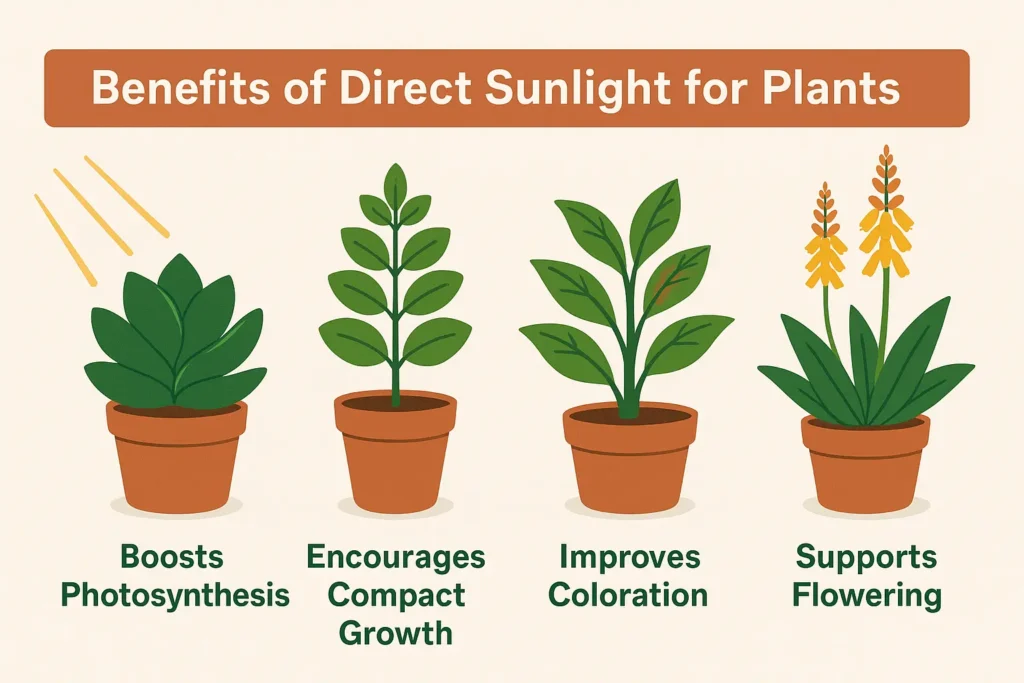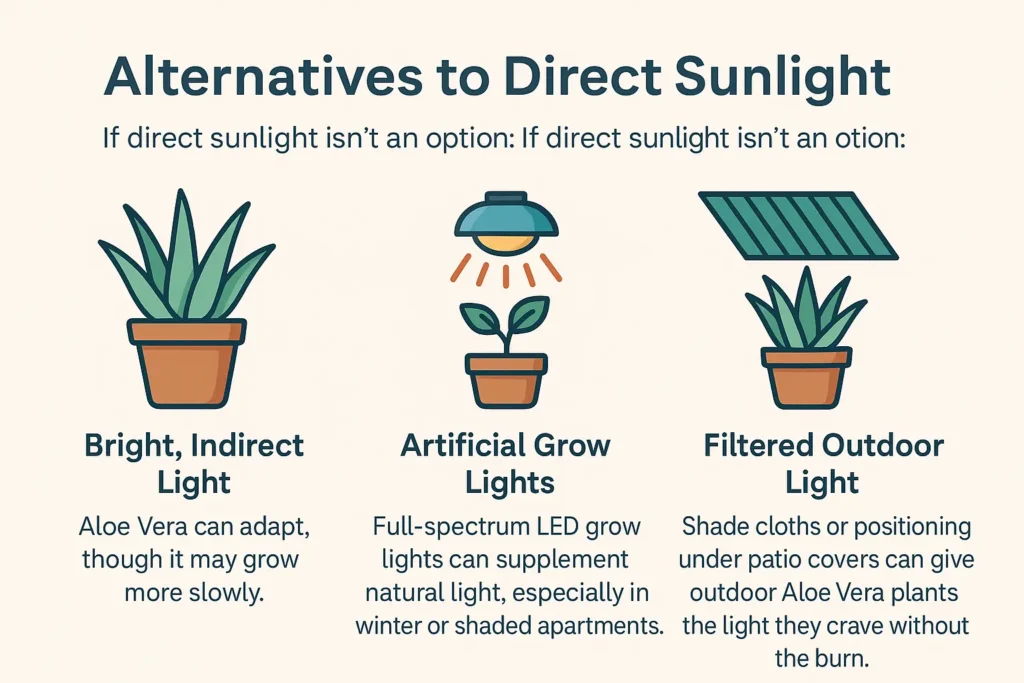Should Aloe Vera Plants Be in Direct Sunlight? A Complete Guide

Should Aloe Vera plants be in direct sunlight?
Aloe Vera plants thrive in bright, direct sunlight, especially when grown outdoors in warm, dry climates. However, prolonged exposure to harsh afternoon sun can lead to leaf scorch and dehydration. Ideally, Aloe Vera should receive 4-6 hours of direct morning sunlight while being shielded from intense midday rays. Observing signs like browning tips or soft, droopy leaves can help you fine-tune its placement.
Introduction
Aloe Vera, with its fleshy, spiky leaves and reputation as a healing plant, is a staple in homes around the world. Known for its soothing gel, Aloe Vera serves both as a practical houseplant and a decorative addition to sunny windowsills. But a common question persists: should Aloe Vera plants be in direct sunlight?
Like all plants, Aloe Vera has its quirks. While it hails from arid regions and adores the sun, too much of a good thing can be harmful. In this guide, we’ll dig into Aloe Vera’s sunlight needs, how to avoid common pitfalls, and how you can ensure your plant stays vibrant and healthy.
Understanding Aloe Vera’s Natural Habitat
Before we dive into plant care specifics, it’s worth understanding where Aloe Vera comes from. Native to the Arabian Peninsula, Aloe Vera thrives in hot, arid climates with plenty of sun. You’ll often find it growing wild in North Africa, the Canary Islands, and southern Europe, where the days are bright and dry.
This background explains a lot about Aloe Vera’s light preferences. It’s evolved to handle intense sunlight but also benefits from conditions where water is scarce, and shade from rocks or other plants offers occasional relief.
Benefits of Direct Sunlight for Aloe Vera
When placed in the right conditions, direct sunlight offers several benefits to Aloe Vera:
- Boosts Photosynthesis: Aloe Vera plants use sunlight to convert energy efficiently, keeping leaves thick and juicy.
- Encourages Compact Growth: Ample sunlight helps Aloe Vera maintain a strong, upright form with dense leaf growth.
- Improves Coloration: Healthy Aloe Vera plants develop a vibrant green hue, sometimes with a reddish tint at the edges, indicating sun exposure.
- Supports Flowering: Though rare indoors, sufficient sunlight can sometimes trigger tall flower stalks with tubular orange or yellow blooms.
For a sun-loving plant like Aloe Vera, regular exposure to direct sunlight is essential for these benefits.
Risks of Excessive Direct Sunlight
But don’t be fooled — Aloe Vera has its limits.
Too much direct sunlight, especially during the scorching afternoon hours, can cause:
- Leaf Scorch and Browning Tips: Signs that your Aloe Vera is sun-stressed.
- Dehydration: Rapid water loss can make leaves thin, wrinkled, or mushy.
- Growth Stagnation: Overexposure can stress the plant, slowing down its natural growth cycle.
It’s important to differentiate between gentle morning sun and harsh midday rays. While Aloe Vera loves light, balance is key to avoid these common issues.
Recommended Light Conditions for Aloe Vera
So, what are the ideal conditions?
- 4-6 Hours of Direct Morning Sunlight: Place Aloe Vera where it can enjoy direct sun in the earlier part of the day.
- Filtered Light in Harsh Afternoon: Use sheer curtains or move the plant slightly away from south-facing windows during peak sun hours.
- Outdoor Placement: In warmer months, Aloe Vera can thrive outside, but consider a partially shaded spot to prevent scorching.
For indoor setups, a bright south or west-facing window is often perfect. Just keep an eye on those leaves for early signs of sunburn.
Alternatives to Direct Sunlight
Not every home has a sun-drenched window. If direct sunlight isn’t an option:
- Bright, Indirect Light: Aloe Vera can adapt, though it may grow more slowly.
- Artificial Grow Lights: Full-spectrum LED grow lights can supplement natural light, especially in winter or shaded apartments.
- Filtered Outdoor Light: Shade cloths or positioning under patio covers can give outdoor Aloe Vera plants the light they crave without the burn.
While not as ideal as the real thing, these alternatives can help maintain a healthy Aloe Vera when direct sunlight is limited.
Seasonal and Location-Based Adjustments
Aloe Vera’s sunlight needs shift with the seasons. In winter, sunlight is weaker, and plants might stretch toward available light. This is the time to move them closer to windows or supplement with grow lights.
Conversely, in peak summer, it’s wise to monitor leaf condition and provide afternoon shade if the sun becomes too intense. Urban environments, with their reflective surfaces, can amplify sunlight and necessitate extra care.
Practical Tips to Manage Light Exposure
Managing sunlight exposure doesn’t have to be complicated:
- Use a Light Meter App: Free apps can measure light intensity at different spots in your home.
- Rotate the Plant: Every couple of weeks, rotate your Aloe Vera to ensure even light distribution.
- Monitor Leaf Health: Watch for pale leaves (too little light) or reddish, scorched tips (too much light).
- Adjust Watering Accordingly: More sunlight means faster evaporation. Check soil moisture before watering.
These small habits go a long way in keeping your Aloe Vera happy.
Conclusion
So, should Aloe Vera plants be in direct sunlight? Absolutely — but with moderation.
Aloe Vera’s desert origins make it a sun-loving plant, but overexposure, especially in harsh afternoon rays, can lead to stress and damage. The sweet spot lies in 4-6 hours of direct morning sunlight, with careful observation and adjustments as needed.
Remember, every home and climate is different. Let your Aloe Vera’s appearance guide you. Vibrant, firm leaves are a sign you’ve found the right balance.
For more resources on plants for direct sunlight, check out our Houseplant Sunlight Guide, where you’ll find tailored advice for different plant species.
Explore More Guides and Calculators
At PlantCalculators, we’re all about making plant care easier. Dive into our other handy guides and tools:
- Mulch Calculator: Find out how much light your specific plant needs.
- Watering Calculator: Personalized watering guides based on your environment.
- Soil Calculator: Get the dirt on soil mixes and feeding routines.
Visit our Houseplants section for a full library of resources designed to help your plants thrive.
Recommended Resource for Further Reading
For expert-backed, science-based houseplant care tips, we highly recommend this comprehensive guide from the University of Illinois Extension. It’s a fantastic resource for learning about indoor plant care, common issues, and best practices.


